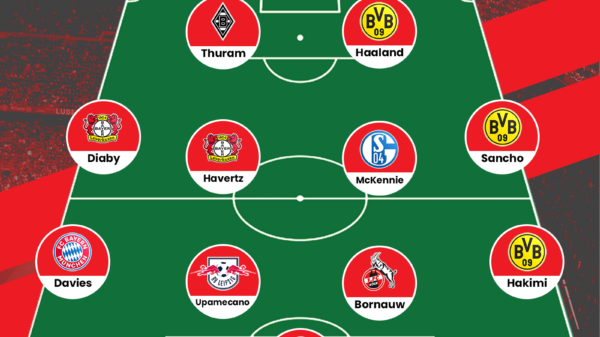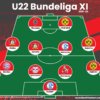James Sutherland writes a detailed tactical analysis about the UEFA Champions League match that ended Borussia Dortmund 8-4 Legia Warsaw.
“C’est magnifique, mais c’est de la folie.” Pierre Bosquet
In football, the line between attack and defense is incredibly thin, even non-existent. In a game where there is little set offense or defense, and where the flow of a match is fluid, the best teams master the ability to defend while attacking, and attack while defending. When a great team has the ball, they aren’t just thinking of how to break down the defense. They’re also thinking about how to prevent the opposition, that defense, from winning the ball back and then counter attacking. Like a chess grandmaster, great players, coaches and teams always think 2-3 moves ahead.
Tuesday night’s Champions League match, between Borussia Dortmund and Legia Warsaw, was a great example of a strong attacking team failing to think ahead. Dortmund’s offense was running on all cylinders, overwhelming Legia in a sea of movements and passes. But they failed to think ahead, leaving themselves unprepared to defend Legia on the counter. Dortmund pinned Legia deep for the vast majority of the match, but when Legia were able to break out they made Dortmund pay for their lack of structure, scoring four times on the counter attack. Dortmund scored eight goals of their own, ensuring the result was never in doubt, but it was not a convincing result for Thomas Tuchel’s men.

Made using Tactical Pad
Dortmund (4-1-4-1): Weidenfeller; Passlack, Bartra, Ginter, Rode; Sahin; Dembele, Castro, Kagawa, Pulisic; Reus
Legia Warsaw (4-2-3-1): Cierzniak; Rzezniczak, Pazdan, Czerwinski, Bereszynski; Guilherme, Kopczynski; Odidja, Radovic, Kucharczyk; Prijovic
Thomas Tuchel added nine new players to the Dortmund side that beat Bayern on the weekend, the only hold overs being center backs Marc Bartra and Matthias Ginter. Even Bartra only started by accident, after Dortmund sent his name in mistakenly, instead of Sokratis. Marco Reus made his return to the field, having been sidelined for 6 months with a leg injury.
Dortmund Overload Center, Attack Down Wings
Dortmund started without a true striker, instead playing Reus up front. While it would be logical to assume that Reus, normally an attacking midfielder, would play as a false nine, that turned out to not be the case. Reus often acted as a normal striker, holding up play and occupying the center backs.
On the whole Dortmund flooded the center of the field. Both wide midfielders, Ousmane Dembele and Christian Pulisic, were wide only on paper. They spent most of the match in the half space, but Tuchel granted them much freedom, allowing them to float into the center and even the opposite half space. This meant that all five of Dortmund’s attack were in the center or half spaces, creating numerous overloads and possibilities for combinations. Legia didn’t have the numbers to control the midfield.
To make up for the lack of width both of Dortmund’s fullbacks pushed high up the field, sometimes so high that they were on Legia’s defensive line. While this added width and created more attacking possibilities, it also left Dortmund vulnerable on the counter, with the wings wide open deep.
Flanks covered by the full-backs, the center over loaded.
Paid off in offensive sense, but the price was also quite clear.#passmap #BVB pic.twitter.com/8zBoln1AsT— 11tegen11 (@11tegen11) November 22, 2016
Dortmund then pushed at times seven players into the attacking third, with just the two center backs and a defensive midfielder, Nuri Sahin, back. It was a bold offensive gamble, and one that paid off in an offensive sense.
Legia, sitting in a passive, deep 4-4-2 block, was completely unable to handle Dortmund’s fluidity and overloads.
Dortmund was able to exploit their numerical superiority in several ways. The most successful and frequent was by splitting Legia’s center and full backs in the half space. Dortmund did this by having Reus hold the ball side centerback down, and then building an overload on the side.

The scene above is perfect example. Reus is keeping the centerback’s attention, while Pulisic has the ball in the half space. Passlack is wide, and Kagawa is in the half space, forcing Legia’s rightback to decide which to mark. In the end, he marks neither and is slow to close down Kagawa, allowing Pulisic to split Legia’s midfield and defensive lines and play Kagawa into the box.

This time Ginter has the ball in the half space. Reus is once again occupying the ball near centerback, while Dembele has moved infield from his wing position. This time Sebastian Rode, Dortmund’s rightback, has advanced, meaning Legia’s leftback must defend two players. He once again doesn’t close down either, and since Legia fail to pressure Ginter he easily makes a cutting pass into Dembele.

Now Dembele has the ball, dribbling at Legia’s backline. More importantly, Dortmund have formed a 3 v. 2, with Rode making a wide open third man run. Dembele ignores him, dribbles infield and loses the ball, but the scene still highlights the greater advantages Dortmund were able to create.
Legia didn’t help themselves defensively. They lacked compactness, allowing Dortmund space to move and exploit, and they lacked ball pressure, allowing Dortmund time on the ball to find the players in those open spaces. Dortmund tore Legia open, making them pay for their defensive weaknesses.
Legia Strike on the Counter
By the same stroke, though, Legia were able to make Dortmund pay for their own poor structure. Because Tuchel pushed so many men forward, and so many in central places, Dortmund were often in poor positions to counterpress, leaving the German team open to counter attacks. Legia took advantage of this.

Above is an example of Dortmund’s extreme offensive numbers. Four players are on Legia’s last line, creating a 4 v. 3 overload. In this case it works out, as Sahin chips over the defense to Kagawa, who passes to Reus for an easy tap in. This aggressiveness was a double edged sword, though. If the ball was lost in this situation, Dortmund would have been in an incredibly vulnerable position, with little ability to counter press.

Look at this scene, from the buildup to Legia’s second goal. Five seconds ago Legia won the ball back, and Dortmund counterpressed hard. However, the Germans were uncoordinated and only succeeded in stopping Legia from immediately countering. Now, however, Warsaw has shifted the ball wide. Meanwhile, five Dortmund players, half of their team, are either behind or level with the ball, in no position to defend. Pulisic is weakly closing down the ball, but the Legia player dribbles past him with ease. From this point on Legia has a man advantage, and are able to exploit the holes in Dortmund’s defense to score.
This was a recurring theme of the match. Although Legia saw little of the ball, just 30% of possession, they created 1.7 expected goals. Dortmund’s lack of counterpress hurt them badly. It forced them to rely on the spotty individual defensive skills of Bartra and Ginter, who were beaten time and again by Legia. Tuchel’s overagressiveness paid off offensively, but defensively left Dortmund wide open.
Conclusion
While Dortmund put on an attacking masterclass, Tuchel will be unsatisfied at the least. Dortmund once again showed an inability to defend, and the problems ran deeper than individuals. The aggressiveness Dortmund showed was a bet, and it paid off offensively. But defensively Dortmund suffered, giving up four goals to a team that had scored just four goals in the previous four Champions League group stage matches.
Dortmund have been struggling defensively all season. Part of their struggles relate to the departure of Mats Hummels, Ilkay Gundogan and Henrik Mkhitaryan, all important cogs of Dortmund’s defensive machine in their own right. But part also relates to Tuchel’s rash tactics. He will need to make changes if Dortmund are going to shore up their domestic campaign.
Read all our Tactical Analyses here.
- Tactical Analysis: Sevilla 2-1 Real Madrid | Sevilla finally end the unbeaten streak - January 21, 2017
- Tactical Analysis: Borussia Dortmund 8-4 Legia Warsaw | Defence thrown out of the windows - November 27, 2016
- Tactical Analysis: RB Leipzig 1-0 Borussia Dortmund | Leipzing outpress Dortmund - September 18, 2016
























































